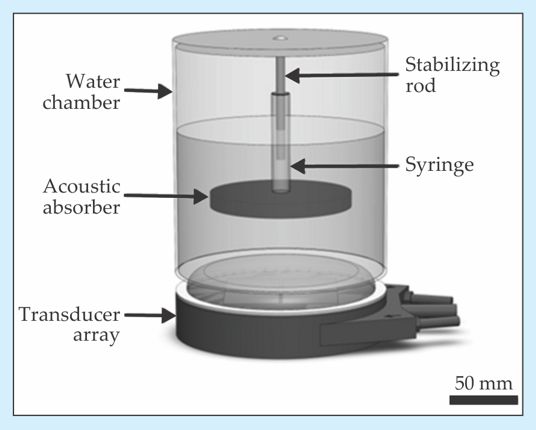Classical vortex beams show their discrete side
DOI: 10.1063/PT.3.1589
Faced with danger, the Doctor, protagonist of the science fiction television series Doctor Who, often availed himself of a tool known as a sonic screwdriver. A bit larger than an ink pen, the sonic screwdriver was, among other things, a lock pick, a remote control, and an alien-detection device. The Doctor’s tool was fictional, of course, but now Michael MacDonald and colleagues at the University of Dundee in the UK, in collaboration with Gabriel Spalding of Illinois Wesleyan University, have developed a real-life sonic screwdriver—an ultrasound device capable of generating high-angular-momentum acoustic vortices. With it, they’ve obtained an elusive measurement of the ratio of orbital angular momentum (OAM) to energy in a vortex beam. 1
The notion that propagating waves can possess OAM is just 20 years old. First advanced by Les Allen and coworkers for the specific case of electromagnetic waves, the conclusion follows from the observation that a light beam’s momentum is always perpendicular to its wavefront. 2 A beam having a helical wavefront should therefore have some OAM about its axis, and a beam made up of several intertwined helical wavefronts should have even more. Each photon, Allen and his colleagues asserted, must have OAM of lℏ, where the integer l is the topological charge—essentially, the number of intertwined helices—and ℏ is the reduced Planck’s constant.
Experiments leave little doubt that helical topology does indeed endow a propagating wave with OAM. (See the article by Miles Padgett, Johannes Courtial, and Les Allen in PHYSICS TODAY, May 2004, page 35
And there’s little reason to suspect that the OAM carried by any vortex beam’s constituent particles—be they photons, phonons, or the like—could be different than lℏ or, equivalently, that the ratio of any beam’s total OAM to its energy, L/E, could be different than l/ω, where ω is the angular frequency. Rigorous analysis of specific propagating-wave solutions seems to show as much. 2,3 Plus, that picture meshes neatly with the broader paradigm of quantum mechanics. Still, experimental confirmation has proved challenging.
In essence, the experiment calls for simultaneously measuring the radiation pressure and torque exerted by a vortex beam on a target. From the radiation pressure, one obtains the energy flux; from the torque, the flux of OAM. One difficulty with optical beams, however, is that they must be focused tightly over a short distance to hold their target—typically a micron-sized or smaller particle—in place on the beam axis. The resulting wide range of incidence angles severely complicates measurement of the radiation pressure. By contrast, acoustic forces are often strong enough to be measured against macroscopic objects, which can be held in place by more convenient means.
Putting twists in an acoustic wave, however, is no trivial matter. Acoustic beams must typically be shaped by coordinating the phases of multiple point sources to give a desired super-position. As a result, generating even a single helical wavefront is a formidable task, and ideally, one would also want to check the theory for cases in which several helices are intertwined. Previously, the benchmark for acoustic vortex beams had been, at most, two intertwined helical wavefronts generated with a half dozen transducers. The Dundee team’s sonic screwdriver, pictured in figure 1, features an array of more than 1000 individually addressable ultrasound transducers and can generate beams with up to 12 intertwined helices.

Figure 1. Sound with a twist.(a) Dubbed a sonic screwdriver, the ultrasound device shown here, roughly 10 cm across, contains a 32 × 32 array of individually addressable transducers. The relative phases of the transducers can be adjusted to customize the shape of an acoustic wave. (b) With this phase profile, for instance, the array would generate a beam of three intertwined helical wavefronts. (Images courtesy of Gabriel Spalding.)

In the team’s experimental setup, depicted in figure 2, the transducer array directs a vortex beam upward toward a sound-absorbing disk submersed in a water chamber. The rising vortex lifts the disk by a distance related to E and spins it at a rate related to L. In the end, OAM theory emerged from the experiment unscathed: The measured ratio L/E plotted against l agreed with predictions to well within experimental error. With one case now closed, the researchers look to use the sonic screwdriver to design nondiffracting Bessel beams and other complex beam shapes that could prove useful for ultrasound surgery.

Figure 2. The experimental setup. The energy and orbital angular momentum of the acoustic beam emitted by a transducer array reveal themselves in the mechanical response of a sound-absorbing disk: The disk levitates by a distance related to the beam energy and rotates at a speed related to the orbital angular momentum. An air-filled syringe, free to slide vertically along the stabilizing rod, helps to buoy the disk and prevent it from tilting. (Adapted from ref.

References
1. C. E. M. Demore et al., Phys. Rev. Lett. 108, 194301 (2012). https://doi.org/10.1103/PhysRevLett.108.194301
2. L. Allen et al., Phys. Rev. A 45, 8185 (1992). https://doi.org/10.1103/PhysRevA.45.8185
3. L. Zhang, P. L. Marston, Phys. Rev. E 84, 065601 (2011).https://doi.org/10.1103/PhysRevE.84.065601




